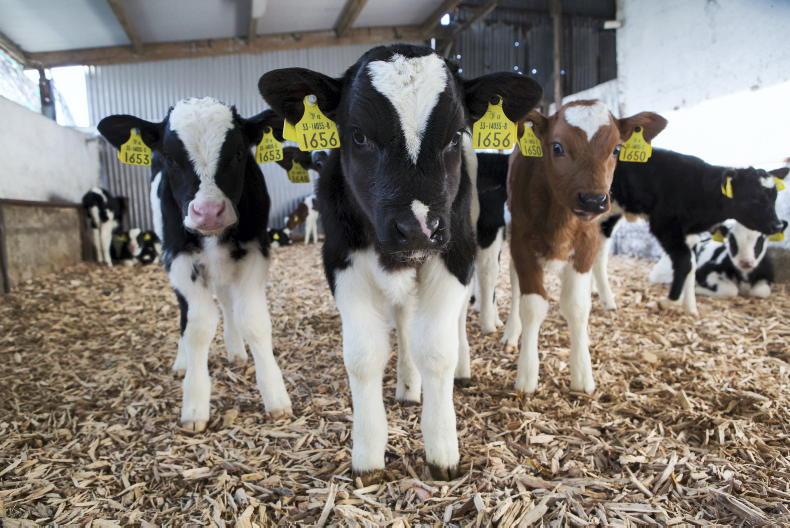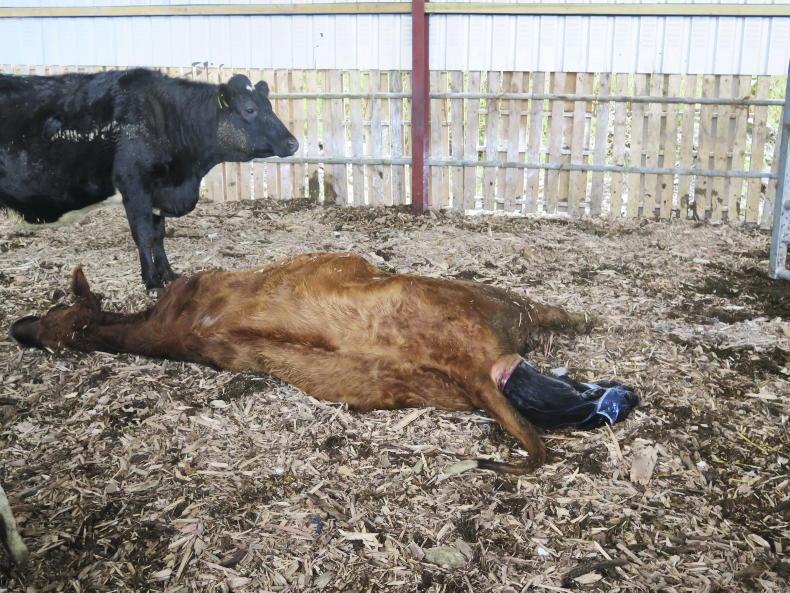With the scarcity of straw across the country, many farmers are facing the prospect of not having enough straw to bed their cattle and calves this spring.
The situation is more acute in areas away from the traditional tillage areas, where farmers don’t necessarily buy straw at harvest time and instead rely on traders who deal in straw for their winter requirements.
The advantages of a good bed when it comes to calf rearing are well-known.
Straw is the traditional bedding material in Ireland and across Europe and is hard to beat in terms of soakage, hygiene and comfort.
For this reason, where straw is scarce it should be prioritised for use on young calves. They are more susceptible to disease and have a lower tolerance to cold and they spend 80% to 90% of their time lying down.
These young calves need a high nesting score – a measure used to determine the effectiveness of the bed in terms of comfort and warmth it provides to calves. A nesting score of three means that the calves’ legs are not visible under the bed, meaning it’s a deep bed and will provide comfort and heat to calves.
There are alternatives to straw, but they generally have a lower nesting score, so are better suited to older animals or older calves and instead prioritise straw to young calves.
Woodchip is probably the best alternative for calves and cattle. While the nesting score of woodchip will be lower than that of straw, it does have insulating properties, so animals lying on woodchip will be warm.
Like straw, it has the ability to soak up moisture at about 2.5 to four times absorbance of its own weight.
Farmers in New Zealand only use woodchip for calf bedding and plenty of Irish farmers have been using woodchip for calf bedding for years also. Some use a combination of woodchip on the floor of the pens and then top up the bed with straw; others just use woodchip throughout.
Best type
The best type of woodchip is also called butt-chip. Bark chips can also be used but woodchips are probably more absorbent. Shavings and sawdust are to be avoided, as they tend to be dusty and have lower absorbency. Sand has no insulating properties and no absorbency, so it should be avoided as a bedding option for calves.
An important consideration regarding woodchip is the moisture content of the chips. If the chips are too wet then they will not be able to absorb the urine and other discharges from livestock.
According to Teagasc, woodchips should have a moisture content of 20% and not greater than 30%.
For this reason, a lot of farmers will purchase woodchip in the summertime and leave it to dry out under cover before using the following winter or spring.
Peat bedding is another option available to farmers, but the extraction of peat carries a very high environmental footprint and so is not recommended.

Calves on woodchip bed which is clean, dry and absorbent.
Even though the peat is not being burned, it is expected that there would be significant carbon losses from the harvest and drying of the peat.
Rubber mats are another option, but they are not recommended for calves on their own because they have a low nesting score and low insulating properties.
Rubber mats are better suited to older animals or can be used in calving pens instead of straw. The pens should be washed out after each calving.
The rubber mats have a grip giving the cow good grip when standing. However, the calf would need to be moved to a more appropriate bed shortly after being born.
Alternatives to straw are available but even so, straw should be prioritised to newborn and young calves. Woodchip is a good alternative to straw for bedding calves and older animals but it must be dried to between 20% and 30% moisture content. Peat bedding carries a very high carbon footprint and shouldn’t be used for that reason.
With the scarcity of straw across the country, many farmers are facing the prospect of not having enough straw to bed their cattle and calves this spring.
The situation is more acute in areas away from the traditional tillage areas, where farmers don’t necessarily buy straw at harvest time and instead rely on traders who deal in straw for their winter requirements.
The advantages of a good bed when it comes to calf rearing are well-known.
Straw is the traditional bedding material in Ireland and across Europe and is hard to beat in terms of soakage, hygiene and comfort.
For this reason, where straw is scarce it should be prioritised for use on young calves. They are more susceptible to disease and have a lower tolerance to cold and they spend 80% to 90% of their time lying down.
These young calves need a high nesting score – a measure used to determine the effectiveness of the bed in terms of comfort and warmth it provides to calves. A nesting score of three means that the calves’ legs are not visible under the bed, meaning it’s a deep bed and will provide comfort and heat to calves.
There are alternatives to straw, but they generally have a lower nesting score, so are better suited to older animals or older calves and instead prioritise straw to young calves.
Woodchip is probably the best alternative for calves and cattle. While the nesting score of woodchip will be lower than that of straw, it does have insulating properties, so animals lying on woodchip will be warm.
Like straw, it has the ability to soak up moisture at about 2.5 to four times absorbance of its own weight.
Farmers in New Zealand only use woodchip for calf bedding and plenty of Irish farmers have been using woodchip for calf bedding for years also. Some use a combination of woodchip on the floor of the pens and then top up the bed with straw; others just use woodchip throughout.
Best type
The best type of woodchip is also called butt-chip. Bark chips can also be used but woodchips are probably more absorbent. Shavings and sawdust are to be avoided, as they tend to be dusty and have lower absorbency. Sand has no insulating properties and no absorbency, so it should be avoided as a bedding option for calves.
An important consideration regarding woodchip is the moisture content of the chips. If the chips are too wet then they will not be able to absorb the urine and other discharges from livestock.
According to Teagasc, woodchips should have a moisture content of 20% and not greater than 30%.
For this reason, a lot of farmers will purchase woodchip in the summertime and leave it to dry out under cover before using the following winter or spring.
Peat bedding is another option available to farmers, but the extraction of peat carries a very high environmental footprint and so is not recommended.

Calves on woodchip bed which is clean, dry and absorbent.
Even though the peat is not being burned, it is expected that there would be significant carbon losses from the harvest and drying of the peat.
Rubber mats are another option, but they are not recommended for calves on their own because they have a low nesting score and low insulating properties.
Rubber mats are better suited to older animals or can be used in calving pens instead of straw. The pens should be washed out after each calving.
The rubber mats have a grip giving the cow good grip when standing. However, the calf would need to be moved to a more appropriate bed shortly after being born.
Alternatives to straw are available but even so, straw should be prioritised to newborn and young calves. Woodchip is a good alternative to straw for bedding calves and older animals but it must be dried to between 20% and 30% moisture content. Peat bedding carries a very high carbon footprint and shouldn’t be used for that reason. 






 This is a subscriber-only article
This is a subscriber-only article











SHARING OPTIONS: